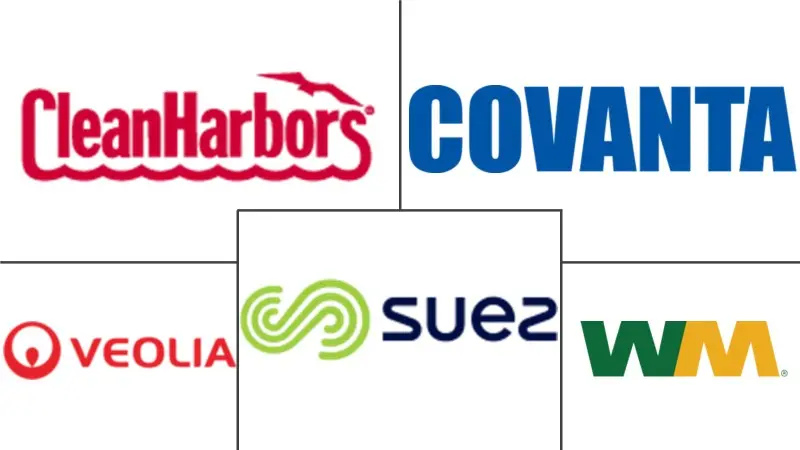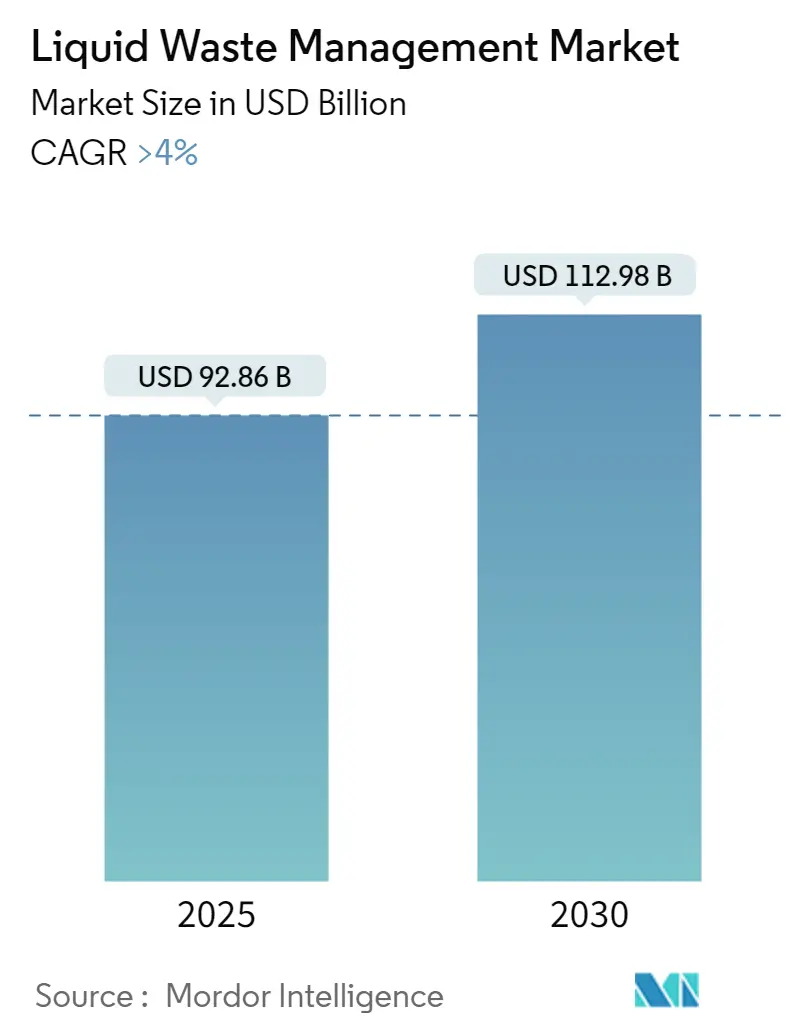
Liquid Waste Management Market Analysis
The Liquid Waste Management Market size is estimated at USD 92.86 billion in 2025, and is expected to reach USD 112.98 billion by 2030, at a CAGR of greater than 4% during the forecast period (2025-2030).
The liquid waste management industry is experiencing significant transformation driven by rapid industrialization and expanding nuclear power infrastructure worldwide. Nuclear power currently accounts for approximately 10% of global electricity generation, with 57 nuclear reactors under construction globally as of June 2023, indicating substantial growth in nuclear-related liquid waste management requirements. The expansion of nuclear facilities, particularly in emerging economies, has necessitated advanced treatment technologies and sophisticated waste handling protocols. This growth in nuclear infrastructure has catalyzed innovations in radioactive liquid waste management treatment methodologies and safety protocols.\\The pulp and paper industry continues to be a major contributor to industrial liquid waste management needs. According to IPMA statistics, member mills produced 4,824 thousand tons of pulp and paper in FY 2022-23, highlighting the significant scale of industrial liquid waste management generation. The industry has witnessed a shift towards more sustainable practices, with companies implementing zero-liquid discharge systems and advanced water recycling technologies. These technological advancements have revolutionized waste treatment processes, enabling higher efficiency and reduced environmental impact across various industrial sectors.\\The oil and gas sector remains a crucial driver of liquid waste management demands, with significant developments in production capacities and waste treatment requirements. Brazil's oil production reached a near-record 41.0 million tons in FY 2022/23, representing a 3.0 million ton increase, exemplifying the growing scale of industrial operations requiring sophisticated waste management solutions. The industry has seen substantial investments in advanced treatment technologies, including enhanced separation techniques, dissolved air flotation, and electro-coagulation processes, particularly for managing produced water and other oil-related liquid wastes.\\The market is witnessing a paradigm shift towards circular economy principles, with an increasing focus on resource recovery and waste-to-value solutions. Treatment facilities are increasingly adopting advanced technologies such as membrane filtration, advanced oxidation processes, and biological treatment systems to handle complex waste streams. The integration of digital technologies, including IoT sensors and automated monitoring systems, has enhanced treatment efficiency and operational control. This technological evolution has enabled more precise treatment processes, improved resource recovery, and better compliance with environmental standards across various industrial applications.\\The waste management industry report highlights these trends and the significant role of the liquid waste management market in driving sustainable practices and technological advancements.
Liquid Waste Management Market Trends
Increased Manufacturing Activities Containing Toxic Chemicals Leading to Growing Liquid Effluent Management
The surge in manufacturing activities across various industrial sectors has led to a significant increase in liquid waste generation containing toxic chemicals. In the textile industry, which is one of the most water-intensive sectors, the dyeing process alone consumes between 30-150 liters of water per kilogram of cloth, generating substantial amounts of contaminated effluent containing high concentrations of dyes, chemicals, and suspended solids. Similarly, the power generation sector, particularly nuclear and fossil fuel power plants, consumes approximately 190 billion gallons of water daily for various operations, creating significant volumes of contaminated wastewater containing hazardous materials and thermal pollution.
The oil and gas industry, being one of the largest generators of industrial wastewater, has witnessed increased production activities, with global oil production reaching 93.9 million barrels per day in 2022, representing a 4% increase from the previous year. This sector generates substantial amounts of wastewater through various operations, including hydrostatic testing, hydraulic fracturing, and refinery processes. For instance, in March 2023, Saudi Aramco announced plans to establish a USD 10 billion refinery and petrochemical project in northeast China, which will further contribute to the generation of industrial liquid waste requiring proper liquid waste treatment and wastewater management. The automotive manufacturing sector also contributes significantly to liquid waste generation, with the United States alone producing over 10 million vehicles in 2022, resulting in substantial amounts of used motor oil, brake fluid, and other chemical-laden wastewaters requiring treatment.
Stringent Government Regulations
Government agencies worldwide have implemented increasingly stringent regulations governing the management and disposal of liquid waste, particularly focusing on industrial effluents containing hazardous materials. In the United States, the Environmental Protection Agency (EPA) has established comprehensive guidelines for wastewater discharge from various industries, with specific emphasis on the treatment of effluents containing toxic metals, organic compounds, and other harmful substances. These regulations mandate industries to implement proper treatment facilities and maintain strict compliance with discharge parameters, driving the demand for sophisticated liquid waste management solutions.
The regulatory framework has become more robust with the implementation of various environmental protection acts and international standards. For instance, the Registration, Evaluation, Authorization, and Restriction of Chemicals (REACH) regulations in Europe have set stringent requirements for chemical handling and waste disposal, requiring companies to conduct thorough Environmental Impact Assessments (EIA) and prepare detailed Environmental Impact Statements (EIS). The EPA has also revised existing regulations on wastewater discharge from thermal power plants, setting the first federal limits on toxic metals and other harmful pollutants in wastewater. These regulations consider zero discharge as the preferred option for pollutants in fly ash transport water, bottom ash transport water, and wastewater from flue gas mercury control systems, compelling industries to adopt advanced wastewater management and fluid waste management solutions to ensure compliance.
Segment Analysis: By Source
Residential Segment in Liquid Waste Management Market
The residential segment dominates the global liquid waste management market, accounting for approximately 43% of the total market revenue in 2024. This significant market share is attributed to the growing focus on clean sanitation and the development of various technologies for treating residential liquid waste. The segment's dominance is further strengthened by government initiatives across major economies taking necessary steps to implement proper residential wastewater management systems. Additionally, increasing urbanization and rising environmental awareness among households have led to greater adoption of systematic liquid waste management practices in residential areas. The segment primarily deals with domestic wastewater, including blackwater and greywater from household activities such as food preparation, washing, bathing, and toilet usage.
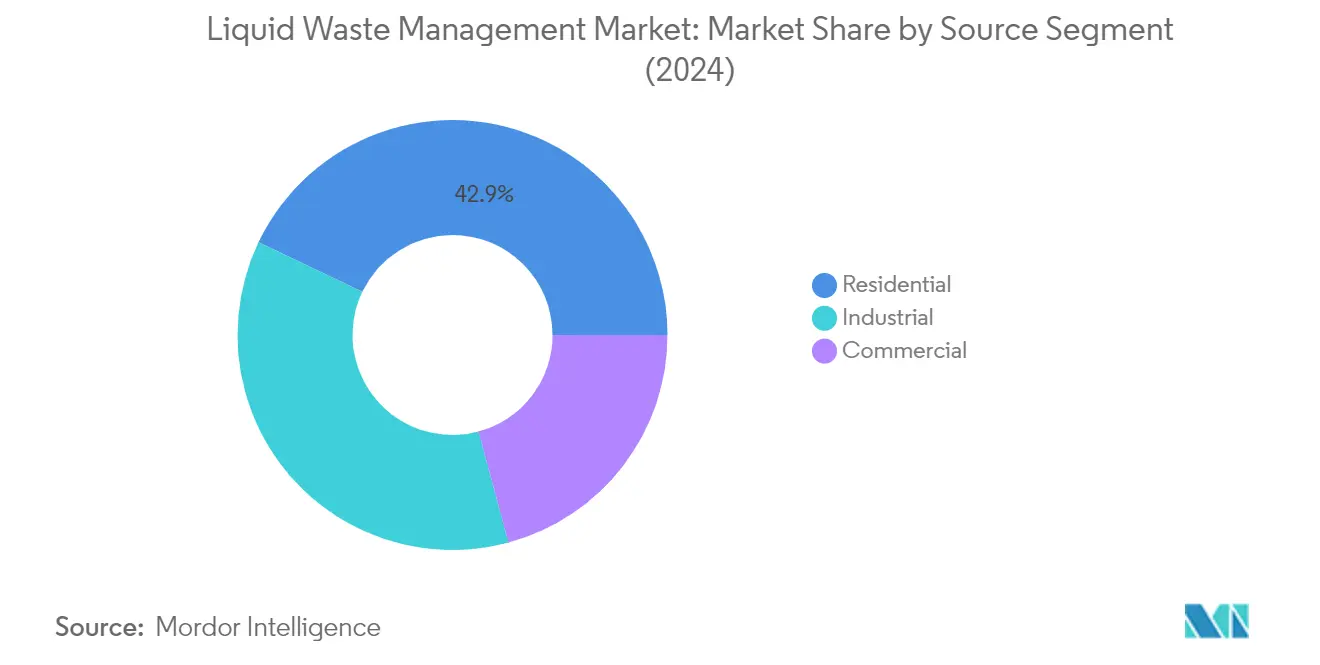
Industrial Segment in Liquid Waste Management Market
The industrial segment is projected to witness the fastest growth in the liquid waste management market, with an expected growth rate of approximately 5% during the forecast period 2024-2029. This accelerated growth is driven by increasing manufacturing activities containing toxic chemicals and stringent government regulations regarding industrial liquid waste management. The segment's growth is particularly notable in sectors such as metal refining, petrochemicals, power generation, and chemical processing industries, where the need for efficient liquid waste treatment is critical. The expansion of industrial facilities across developing economies, coupled with growing environmental concerns and regulatory compliance requirements, is expected to further boost the segment's growth. Additionally, the adoption of advanced treatment technologies and sustainable waste management practices by industrial facilities is contributing to the segment's rapid expansion.
Commercial Segment in Liquid Waste Management
The commercial segment plays a vital role in the liquid waste management market, serving businesses, shops, open marketplaces, restaurants, and cafes. This segment primarily handles wastewater that resembles household waste but often contains higher concentrations of specific contaminants, particularly from food service establishments. The segment has unique characteristics as commercial areas typically generate lower per-capita wastewater compared to residential areas, since people spend only working hours on these premises. The segment's importance is highlighted by the growing number of commercial establishments and the increasing focus on proper waste management practices in business districts and commercial zones.
Segment Analysis: By Service
Transportation/Hauling Segment in Liquid Waste Management Market
The transportation/hauling segment dominates the liquid waste management market, accounting for approximately 52% of the total market share in 2024. This segment's prominence is attributed to the critical role it plays in moving liquid waste from storage areas to recycling and processing facilities. The transportation of liquid waste requires specialized vehicles and equipment, including vacuum trucks, bulk tankers, and pneumatic trailers, to ensure safe and compliant waste movement. Companies operating in this segment must adhere to strict regulatory requirements as waste transported by vehicle must be monitored carefully to prevent spilling and leaking. The segment's large market share also reflects the increasing volumes of liquid waste being generated across various industries and the growing distances between waste generation points and treatment facilities.
Disposal/Recycling Segment in Liquid Waste Management Market
The disposal/recycling segment is emerging as the fastest-growing segment in the liquid waste management market, with a projected growth rate of approximately 5% from 2024 to 2029. This growth is driven by increasing environmental regulations and a growing focus on sustainable waste management practices. The segment encompasses various treatment methods including dewatering, sedimentation, composting, incineration, root-zone treatment, and solidification processes. The rising adoption of advanced treatment technologies and the increasing emphasis on resource recovery and circular economy principles are fueling this segment's growth. Additionally, the development of innovative recycling technologies and the implementation of zero-liquid discharge systems in industrial applications are contributing to the segment's rapid expansion.
Remaining Segments in Service Segmentation
The collection segment plays a vital role in the liquid waste management market by providing essential waste segregation, loading, unloading, and storage services. This segment involves the gathering of various types of liquid waste from residential, commercial, and industrial sources. Collection services are becoming increasingly sophisticated with the implementation of advanced monitoring systems and specialized equipment for different types of liquid waste. The segment's operations are critical in ensuring proper waste segregation at the source, which significantly impacts the efficiency of subsequent transportation and treatment processes. Companies in this segment are increasingly focusing on developing innovative collection methods and improving their storage facilities to meet growing environmental compliance requirements.
Segment Analysis: By End-User Industry
Metal Refining Segment in Liquid Waste Management Market
The metal refining segment, including iron and steel industries, dominates the liquid waste management market with approximately 33% revenue share in 2024. This significant market share is primarily attributed to the fact that many metal refining plants are situated in environments where water scarcity is a major concern. The increasing population and continuous surging demand for water have made it crucial for metal refineries to minimize water usage and focus on better wastewater management practices. The segment's dominance is further strengthened by the implementation of various recycling initiatives, particularly in major markets like China, where wastewater recycling in the iron and steel industry has surged significantly, leading to substantial reductions in freshwater consumption while maintaining high production outputs.
Power Generation Segment in Liquid Waste Management Market
The power generation segment is projected to exhibit the fastest growth in the liquid waste management market, with an expected CAGR of approximately 6% during 2024-2029. This robust growth is primarily driven by the increasing number of nuclear reactors worldwide and the stringent regulations regarding wastewater discharge from thermal power plants. The segment's growth is further supported by the fact that even after reactor shutdown, radioactive isotopes in the fuel continue to decay and produce heat, requiring substantial amounts of water for cooling over extended periods. Additionally, the implementation of zero liquid discharge policies and the growing focus on sustainable water management practices in power generation facilities are contributing to the segment's rapid expansion.
Remaining Segments in End-User Industry
The liquid waste management market encompasses several other significant end-user industries, each with unique waste management requirements. The petrochemicals and refineries segment generates substantial amounts of contaminated wastewater requiring specialized treatment processes. The leather industry contributes significantly due to its water-intensive processes and the presence of various chemical contaminants. The chemical industry segment focuses on managing complex waste streams containing various organic and inorganic compounds. The textile sector generates highly colored effluents requiring specialized treatment, while the food and beverages industry deals with organic-rich wastewater. The pulp and paper industry, sugar industry, and other end-users also contribute to the market's diversity through their specific liquid waste management needs and regulatory compliance requirements.
Segment Analysis: By Type
Hazardous Waste Segment in Liquid Waste Management Market
The hazardous waste segment dominates the global liquid waste management market, accounting for approximately 57% of the total market revenue in 2024. This significant market share is primarily driven by stringent regulations toward hazardous waste management across major economies worldwide. The segment's dominance is further strengthened by increased manufacturing activities containing toxic chemicals, particularly in industries such as petrochemicals, metal refining, and chemical processing. The growing focus on proper disposal and treatment of hazardous materials from various industrial processes, including nuclear power generation, oil and gas operations, and pharmaceutical manufacturing, continues to drive the segment's growth. Additionally, the rising awareness about environmental protection and the implementation of strict compliance requirements for hazardous waste handling and disposal have made this segment crucial for the overall market dynamics.
Non-hazardous Waste Segment in Liquid Waste Management Market
The non-hazardous waste segment is projected to be the fastest-growing segment in the liquid waste management market, with an expected growth rate of approximately 4.3% during the forecast period 2024-2029. This growth is primarily attributed to the increasing volume of municipal and residential wastewater requiring treatment and disposal. The segment is experiencing rapid expansion due to urbanization and the growing focus on sustainable waste management practices in residential and commercial sectors. The implementation of advanced treatment technologies and the rising adoption of recycling and reuse practices for non-hazardous liquid waste are further propelling this segment's growth. Additionally, the development of innovative treatment solutions and the increasing investment in wastewater treatment infrastructure across developing regions are contributing to the segment's accelerated growth trajectory. The segment is also benefiting from the growing awareness about water conservation and the need for proper disposal of non-hazardous liquid waste from various commercial establishments.
Liquid Waste Management Market Geography Segment Analysis
Liquid Waste Management Market in Asia-Pacific
The Asia-Pacific region represents a significant liquid waste management market, driven by rapid industrialization, urbanization, and stringent environmental regulations. Countries like China, India, Japan, and South Korea are key contributors to the regional market growth. The region's expansion is supported by increasing manufacturing activities, growing awareness about environmental protection, and government initiatives promoting proper liquid waste management practices. Infrastructure development and technological advancements in waste treatment facilities further strengthen the market presence across these nations.
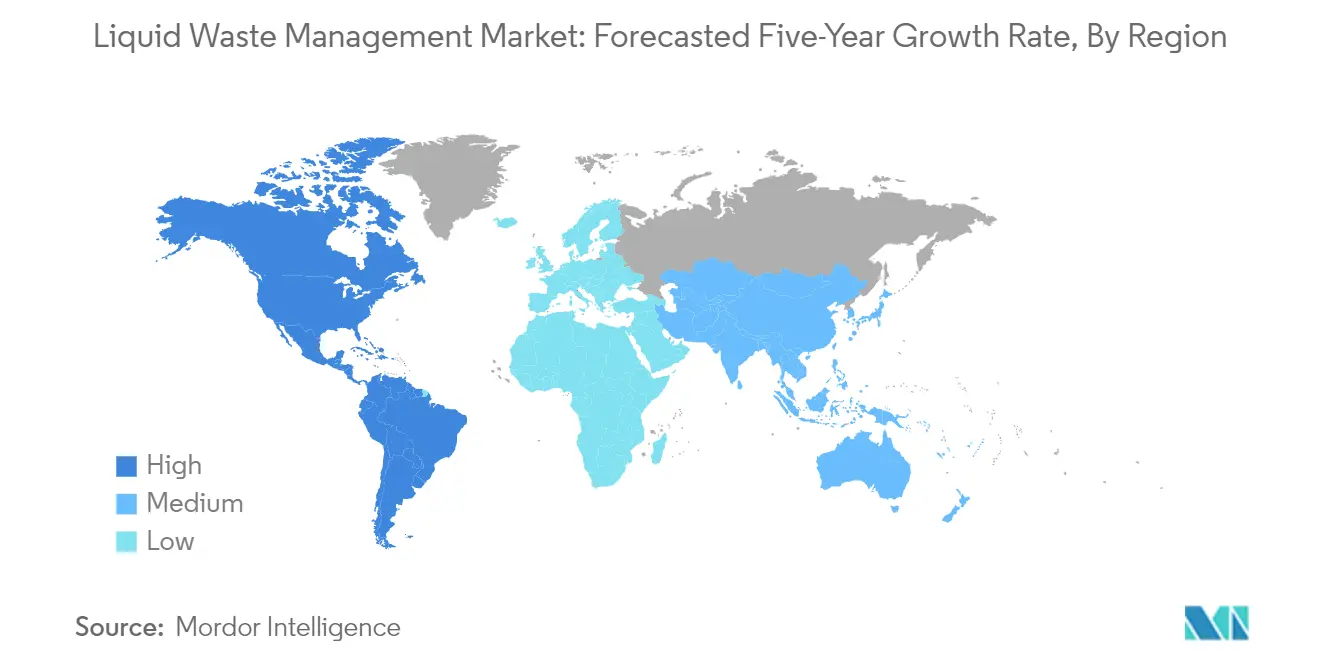
Liquid Waste Management Market in China
China dominates the Asia-Pacific liquid waste management market, holding approximately 45% of the regional market share in 2024. The country's market leadership is attributed to its massive industrial base, extensive manufacturing activities, and robust environmental protection policies. The Chinese government's commitment to addressing environmental challenges through stricter regulations and increased investments in waste management infrastructure has created a favorable market environment. The presence of numerous chemical, petrochemical, and manufacturing facilities, coupled with growing urbanization and industrial development, continues to drive demand for liquid waste management services in the country.
Liquid Waste Management Market in India
India emerges as one of the fastest-growing markets in the Asia-Pacific region, with a projected growth rate of approximately 4% during 2024-2029. The country's market expansion is driven by rapid industrialization, growing environmental concerns, and increasing government focus on clean India initiatives. The implementation of stringent environmental regulations, particularly in industrial sectors such as textiles, chemicals, and pharmaceuticals, has accelerated the adoption of proper liquid waste management practices. Additionally, the country's expanding manufacturing sector and rising awareness about environmental protection contribute significantly to market growth.
Liquid Waste Management Market in North America
North America maintains a leading position in the global liquid waste management market, characterized by advanced infrastructure, stringent environmental regulations, and high technological adoption rates. The United States, Canada, and Mexico collectively contribute to the region's market dominance, with each country implementing comprehensive waste management frameworks. The region's market is driven by robust industrial activities, strict regulatory compliance requirements, and increasing focus on sustainable wastewater management practices.
Liquid Waste Management Market in United States
The United States leads the North American market, commanding approximately 69% of the regional market share in 2024. The country's dominant position is supported by its extensive industrial base, advanced waste management infrastructure, and stringent environmental regulations. The presence of major industry players, coupled with continuous technological innovations in waste treatment processes, reinforces the country's market leadership. The US market benefits from strong regulatory frameworks, increasing industrial activities, and growing emphasis on sustainable wastewater management practices.
Liquid Waste Management Market in Canada
Canada demonstrates strong market potential with a projected growth rate of approximately 5% during 2024-2029. The country's market expansion is driven by increasing industrial activities, stringent environmental regulations, and growing focus on sustainable wastewater management practices. The Canadian government's emphasis on environmental protection, coupled with rising investments in waste management infrastructure, contributes to market growth. The country's robust mining, oil and gas, and manufacturing sectors continue to generate significant demand for liquid waste management services.
Liquid Waste Management Market in Europe
Europe represents a mature market for liquid waste management, characterized by advanced infrastructure, stringent environmental regulations, and high environmental consciousness. The region encompasses key markets including Germany, United Kingdom, France, and Italy, each contributing significantly to the overall market dynamics. The European Union's strict environmental policies and circular economy initiatives drive the adoption of efficient waste management practices across the region.
Liquid Waste Management Market in Germany
Germany maintains its position as the largest market for liquid waste management in Europe. The country's leadership is attributed to its strong industrial base, particularly in automotive, chemical, and manufacturing sectors. Germany's comprehensive environmental regulations and advanced waste management infrastructure support market growth. The country's commitment to sustainable development and circular economy principles continues to drive innovations in waste management practices.
Liquid Waste Management Market in France
France emerges as the fastest-growing market in Europe for liquid waste management. The country's market growth is driven by increasing industrial activities, stringent environmental regulations, and growing emphasis on sustainable waste management practices. France's focus on technological advancement in waste treatment processes and strong presence of key industry players contributes to market expansion. The country's commitment to environmental protection and circular economy principles further supports market development.
Liquid Waste Management Market in South America
The South American liquid waste management market demonstrates significant growth potential, with Brazil and Argentina serving as key markets in the region. The market is characterized by increasing industrial activities, growing environmental awareness, and evolving regulatory frameworks. Brazil emerges as both the largest and fastest-growing market in the region, driven by its extensive industrial base and government initiatives promoting proper waste management practices. The region's market development is supported by increasing investments in waste management infrastructure and growing emphasis on environmental protection.
Liquid Waste Management Market in Middle East & Africa
The Middle East & Africa region presents emerging opportunities in the liquid waste management market, with Saudi Arabia and South Africa as key contributing countries. The market is driven by rapid industrialization, increasing environmental awareness, and growing government initiatives for proper waste management. Saudi Arabia represents the largest market in the region, while South Africa demonstrates the fastest growth potential. The region's market development is supported by increasing investments in infrastructure development and growing emphasis on sustainable waste management practices.
Liquid Waste Management Industry Overview
Top Companies in Liquid Waste Management Market
The global liquid waste management market is characterized by continuous innovation and strategic expansion by key players like Veolia, Clean Harbors, WM Intellectual Property Holdings, SUEZ, and GFL Environmental Inc. Companies are increasingly focusing on developing sustainable waste management solutions, including advanced treatment technologies and recycling processes to address growing environmental concerns. The industry witnesses regular technological advancements in areas like ultrafiltration systems, vacuum evaporation, reverse osmosis, and specialized transportation equipment. Market leaders are expanding their geographical presence through strategic acquisitions and partnerships, particularly in emerging markets. Operational excellence is being achieved through investments in digitalization, automation of waste collection and processing, and development of integrated end-to-end waste management solutions. Companies are also emphasizing research and development to improve resource recovery rates and reduce environmental impact while meeting stringent regulatory requirements.
Fragmented Market with Strong Regional Players
The liquid waste management industry exhibits a fragmented structure with a mix of global environmental services conglomerates and specialized regional operators. Major global players leverage their extensive infrastructure networks, technological capabilities, and financial resources to maintain market leadership, while regional specialists thrive by offering customized solutions and maintaining strong local relationships. The market is witnessing increased consolidation through mergers and acquisitions, as larger companies seek to expand their service portfolios and geographical coverage while smaller players look to access new technologies and markets.
The competitive dynamics are shaped by the presence of diversified environmental services companies that offer comprehensive waste management solutions alongside specialized firms focusing exclusively on liquid waste treatment. Market consolidation is driven by the need for economies of scale, access to advanced technologies, and the ability to serve multinational clients across regions. Companies are increasingly pursuing strategic partnerships and joint ventures to enhance their service offerings and strengthen their market position, particularly in emerging economies where regulatory frameworks are evolving and demand is growing rapidly.
Innovation and Sustainability Drive Future Growth
Success in the liquid waste management market increasingly depends on companies' ability to offer innovative, sustainable solutions while maintaining cost competitiveness. Incumbent players are focusing on developing proprietary technologies, expanding their treatment facility networks, and strengthening relationships with key industrial clients to maintain their market position. The ability to provide integrated waste management solutions, invest in advanced treatment technologies, and demonstrate strong environmental compliance will be crucial for market leadership. Companies are also emphasizing digital transformation and operational efficiency to enhance service delivery and customer experience.
For emerging players and contenders, success lies in identifying and serving underserved market segments, developing specialized treatment solutions for specific industries, and building a strong local presence. The increasing focus on environmental regulations and sustainability creates opportunities for companies offering innovative treatment technologies and circular economy solutions. Market participants must also consider the growing influence of end-user industries in driving service requirements and pricing dynamics. The ability to adapt to evolving regulatory standards, particularly regarding hazardous waste treatment and disposal, will be critical for long-term success in this market. The waste management industry report highlights the importance of these factors in shaping future growth trajectories.
Liquid Waste Management Market Leaders
-
SUEZ
-
Veolia
-
Covanta Holding Corporation
-
WM Intellectual Property Holdings, L.L.C.
-
CLEAN HARBORS, INC.
- *Disclaimer: Major Players sorted in no particular order
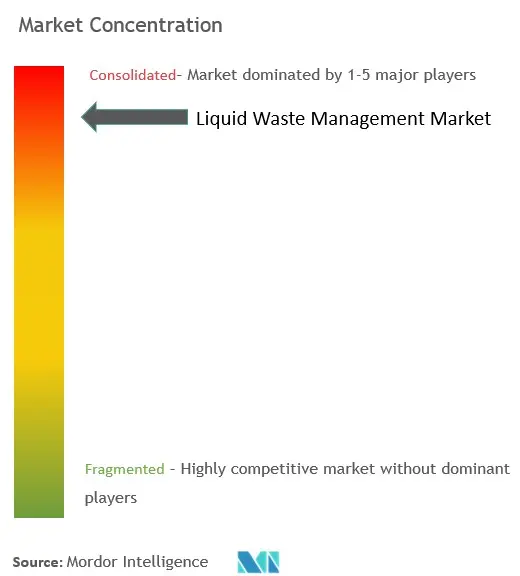
Liquid Waste Management Market News
- October 2023: SUEZ Recycling and Recovery UK completed the acquisition of Devon Contract Waste (DCW), a prominent recycling and waste management company. This strategic move is aimed at enhancing SUEZ's global position within the waste sector.
- September 2023: SUEZ took a significant step in supporting China's 2060 carbon neutrality ambition by entering into two new contracts for water and waste projects. Collaborating with Chongqing Water Group (CWG), SUEZ will jointly invest in the construction and operation of a water treatment plant, contributing to the enhancement of the municipality's water supply system.
- January 2022: Veolia announced the successful conclusion of the sale of the new SUEZ to a consortium of investors comprising Meridiam, GIP, CDC Group, and CNP Assurances. This transaction marked a key development in the restructuring of the industry landscape.
Liquid Waste Management Market Report - Table of Contents
1. INTRODUCTION
- 1.1 Study Assumptions
- 1.2 Scope of the Study
2. RESEARCH METHODOLOGY
3. EXECUTIVE SUMMARY
4. MARKET DYNAMICS
-
4.1 Drivers
- 4.1.1 Growth in the Pharmaceutical and Healthcare Industry
- 4.1.2 Increased Manufacturing Activities Containing Toxic Chemicals Leading to Growing Liquid Effluent Management
- 4.1.3 Other Drivers
-
4.2 Restraints
- 4.2.1 Increasing Technological Challenges
- 4.2.2 Stringent Waste Processing Regulations
- 4.2.3 Other Restraints
- 4.3 Industry Value Chain Analysis
-
4.4 Porter's Five Forces Analysis
- 4.4.1 Bargaining Power of Suppliers
- 4.4.2 Bargaining Power of Buyers
- 4.4.3 Threat of New Entrants
- 4.4.4 Threat of Substitute Products and Services
- 4.4.5 Degree of Competition
5. MARKET SEGMENTATION (Market Size in Value)
-
5.1 Source
- 5.1.1 Residential
- 5.1.2 Commercial
- 5.1.3 Industrial
-
5.2 Service
- 5.2.1 Collection
- 5.2.2 Transportation/Hauling
- 5.2.3 Disposal/Recycling
-
5.3 End-user Industry
- 5.3.1 Automotive
- 5.3.2 Iron and Steel
- 5.3.3 Oil and Gas
- 5.3.4 Pharmaceutical
- 5.3.5 Textile
- 5.3.6 Other End-user Industries (Pulp and Paper, Food and Beverages, etc.)
-
5.4 Geography
- 5.4.1 Asia-Pacific
- 5.4.1.1 China
- 5.4.1.2 India
- 5.4.1.3 Japan
- 5.4.1.4 South Korea
- 5.4.1.5 Rest of Asia-Pacific
- 5.4.2 North America
- 5.4.2.1 United States
- 5.4.2.2 Canada
- 5.4.2.3 Mexico
- 5.4.3 Europe
- 5.4.3.1 Germany
- 5.4.3.2 United Kingdom
- 5.4.3.3 France
- 5.4.3.4 Italy
- 5.4.3.5 Rest of Europe
- 5.4.4 South America
- 5.4.4.1 Brazil
- 5.4.4.2 Argentina
- 5.4.4.3 Rest of South America
- 5.4.5 Middle-East and Africa
- 5.4.5.1 Saudi Arabia
- 5.4.5.2 South Africa
- 5.4.5.3 Rest of Middle-East and Africa
6. COMPETITIVE LANDSCAPE
- 6.1 Mergers and Acquisitions, Joint Ventures, Collaborations, and Agreements
- 6.2 Market Share (%)**/Ranking Analysis
- 6.3 Strategies Adopted by Leading Players
-
6.4 Company Profiles
- 6.4.1 CLEAN HARBORS, INC.
- 6.4.2 Cleanaway
- 6.4.3 Covanta Holding Corporation
- 6.4.4 Enva
- 6.4.5 GFL Environmental Inc.
- 6.4.6 Hulsey (a Blue Flow Company)
- 6.4.7 Ovivo
- 6.4.8 REMONDIS SE & Co. KG
- 6.4.9 SUEZ
- 6.4.10 Veolia
- 6.4.11 WM Intellectual Property Holdings, L.L.C.
- *List Not Exhaustive
7. MARKET OPPORTUNITIES AND FUTURE TRENDS
- 7.1 The Rising Water Crisis Globally is Creating New Opportunities for Liquid Waste Management
- 7.2 Increasing Focus on Treating Emerging Contaminates
Liquid Waste Management Industry Segmentation
Liquid waste management is the procedure and practice to prevent the discharge of pollutants, toxic chemicals, and other hazardous liquid byproducts to water bodies or drainage systems. Liquid waste contamination is highly important as liquid waste adversely affects humans and animals by contaminating water, soil, or the air. Therefore, proper handling is highly essential to reduce the spread of diseases, the risk of ruining crops, etc.
The liquid waste management market is segmented by source, service, end-user industry, and geography. By source, the market is segmented into residential, commercial, and industrial. By service, the market is segmented into collection, transportation/hauling, and disposal/recycling. By end-user industry, the market is segmented into automotive, iron and steel, oil and gas, pharmaceutical, textile, and other end-user industries (paper and pulp, food and beverages, etc.). The report also covers the market size and forecasts for the market in 15 countries across the globe.
For each segment, the market sizing and forecasts have been done on the basis of value (USD).
| Source | Residential | ||
| Commercial | |||
| Industrial | |||
| Service | Collection | ||
| Transportation/Hauling | |||
| Disposal/Recycling | |||
| End-user Industry | Automotive | ||
| Iron and Steel | |||
| Oil and Gas | |||
| Pharmaceutical | |||
| Textile | |||
| Other End-user Industries (Pulp and Paper, Food and Beverages, etc.) | |||
| Geography | Asia-Pacific | China | |
| India | |||
| Japan | |||
| South Korea | |||
| Rest of Asia-Pacific | |||
| North America | United States | ||
| Canada | |||
| Mexico | |||
| Europe | Germany | ||
| United Kingdom | |||
| France | |||
| Italy | |||
| Rest of Europe | |||
| South America | Brazil | ||
| Argentina | |||
| Rest of South America | |||
| Middle-East and Africa | Saudi Arabia | ||
| South Africa | |||
| Rest of Middle-East and Africa | |||
Liquid Waste Management Market Research FAQs
How big is the Liquid Waste Management Market?
The Liquid Waste Management Market size is expected to reach USD 92.86 billion in 2025 and grow at a CAGR of greater than 4% to reach USD 112.98 billion by 2030.
What is the current Liquid Waste Management Market size?
In 2025, the Liquid Waste Management Market size is expected to reach USD 92.86 billion.
Who are the key players in Liquid Waste Management Market?
SUEZ, Veolia, Covanta Holding Corporation, WM Intellectual Property Holdings, L.L.C. and CLEAN HARBORS, INC. are the major companies operating in the Liquid Waste Management Market.
Which is the fastest growing region in Liquid Waste Management Market?
North America is estimated to grow at the highest CAGR over the forecast period (2025-2030).
Which region has the biggest share in Liquid Waste Management Market?
In 2025, the North America accounts for the largest market share in Liquid Waste Management Market.
What years does this Liquid Waste Management Market cover, and what was the market size in 2024?
In 2024, the Liquid Waste Management Market size was estimated at USD 89.15 billion. The report covers the Liquid Waste Management Market historical market size for years: 2019, 2020, 2021, 2022, 2023 and 2024. The report also forecasts the Liquid Waste Management Market size for years: 2025, 2026, 2027, 2028, 2029 and 2030.
Our Best Selling Reports
Liquid Waste Management Market Research
Mordor Intelligence provides a comprehensive analysis of the liquid waste management industry. With decades of expertise in industrial liquid waste management research, our extensive coverage includes fluid waste management, waste water management, and wastewater management sectors. We offer detailed insights into market dynamics and technological innovations. The report, available as an easy-to-download PDF, presents a thorough analysis of wet waste management solutions and liquid waste treatment methodologies. This is supported by extensive primary research and data validation.
The report offers invaluable insights for waste water management companies and industry stakeholders. It features detailed profiles of leading wastewater management companies and their strategic initiatives. Our wastewater management report includes a comprehensive analysis of emerging technologies, regulatory frameworks, and regional market developments in liquid waste management. Stakeholders benefit from actionable intelligence on industrial liquid waste handling processes, enabling informed decision-making and strategic planning. The waste management industry report provides crucial data points and forecasts, helping businesses identify growth opportunities and optimize their operational efficiency in the evolving waste management landscape.

